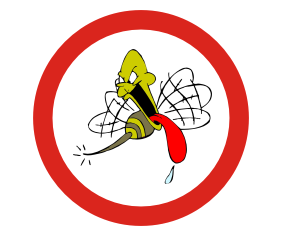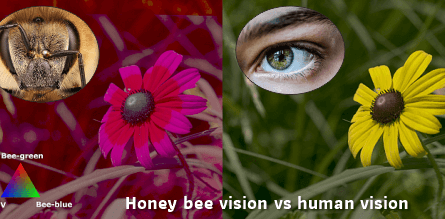In spring canola fields are a breathtaking sight. People stop their cars and take lots of pictures. But oftentimes they also complain of being stung by rather aggressive bees. The truth is relative but yes, sometimes bees are aggressive in spring, in canola fields.
And while experienced beekeepers know very well how to manage honey bees during canola nectar harvest, a tourist may not know how to behave around so many bees.
Spring is a wonderful season. For the entire nature and especially for honey bees. After dealing with cold and less food all winter, they now have the chance to literary start life again. This can be a good motive to be happy but somehow honey bees are oftentimes aggressive.
Why are honey bees aggressive?
Beekeepers have different opinions on that. Some say their bees are never aggressive and some even end up killing the queen and relocating the family to other less aggressive hives. Nevertheless we don’t speak here about the reasons of bees being aggressive towards their beekeeper and we refer strictly at their bad behavior around other people.
There are tons of reasons for which honey bees can become aggressive. First of all we must always remember that honey bees have not been domesticated! They are tolerant to us, because we improve their living conditions.
Other than that humans should never dare to upset them somehow because they are willing to die to protect their food and family. Therefor beekeepers know very well what to avoid and how to handle them. Somehow we can even say that honey bees are the ones that have domesticated humans.
The article How to treat bee sting shows more in detail what should we do and don’t in order to avoid being attacked by bees. Supposing you don’t go to a hive and start kicking it or play the drums next to it, here are the most important things a person should not do around honey bees:
Don’t crash them! Don’t wear dark colors, or striped clothes! Be odorless! Bees hate powerful smells, no matter if it’s Chanel or sweat, alcohol or onion! Stay calm and don’t bother them!
These rules apply for worker honey bees foraging in a field. If you see a bunch of bees that fly too much next to you, buzzing around over your head – a thing that would indicate they are upset by something, simply go away. Do not try to send them away with your hands, it will only make them angrier.
Besides these obvious reasons for getting angry, there are other things that contribute to bees being aggressive. We often say “they attacked us for no reason” – but that’s not true. Even if we haven’t provoked them somehow, other hidden reasons might trigger this behavior.
Why are bees aggressive in spring?
Each season can induce aggressiveness. In summer for example, too much hot and lack of water can be the reasons. The population grows during summer, weather may have rapid changes and that’s why honey bees are known to also have a bad temper in late summer and fall. But in spring? What could be the reason?
Some beekeepers say the bees could have been suffering from hunger during winter, the weather may be too rainy, the nectar could not be enough, beekeepers could move the hives in improper conditions or handle them badly. No matter the season, beekeepers can make mistakes, but weather and flower can greatly contribute to bees’ behavior.
Among the first melliferous flowers that grow in spring we can list dandelions, rapeseed (canola) and black locust (acacia).
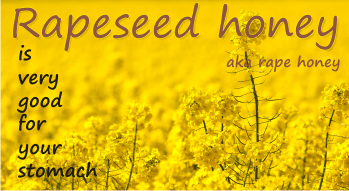 Rape flowers (canola flowers) are a real challenge!
Rape flowers (canola flowers) are a real challenge!
In many places canola honey is one of the first honeys which is harvested. Canola flowers offer an abundance of both nectar and pollen though frequently the nectar does not yield until the weather is warm enough.
These flowers can represent a major benefit in the management of honey bees but can also create major problems in bee management.
Once the winter is gone, the behavior of honey bees will depend on the hive’s status.
1. If the colony is healthy and strong in population then the colony will quickly react to the available nectar and pollen and will immediately begin foraging. But too many bees will congest the hive and lead to serious
swarming problems.
Beekeepers are required several activities to minimize the swarming: remove all capped honey and extract it; move the brood — either to another hive (a weak hive) or above the queen excluder; place 1–3 frames of foundation and/or empty drawn comb in the brood nest area; plan on regular re-queening in late spring through to early autumn — at either 12 or 18 month intervals, and so on. Even removing the hives from the canola crops if it is increasingly difficult to stop swarming. Activities that beekeepers know very well.
2. A weak colony should benefit from canola flowers and encourage them to breed. If the winter has been very cold and the bees suffered from Nosema disease, these flowers could help the colony overcome the disease by enabling the bees to rapidly breed and expand the population, displacing the old bees and quickly populating the hive with young, healthy bees.
Nevertheless, the reverse can happen just as often. The adult workers are placed under so much stress, foraging for pollen and nectar, ripening nectar and keeping the brood area warm, that the longevity of the bees is reduced
and the hive population declines. This, particularly when combined with poor weather, will lead to increased levels of Nosema disease.
Beyond these activities and, of course, others necessary to sanitize the hive and prepare it for the honey season, when harvesting rape honey beekeepers have to extract it very quickly from the combs. This type of honey has high glucose content and crystallizes very quickly, even inside the hive. It will crystallize in the comb while still in the field! So, as soon as the cells are capped the honey should be extracted and placed into glass jars in dark, cool rooms. It may last 3 to 4 weeks before it crystallizes in the jar.
But why would a tourist care about these activities which are not his business?
Rape flowers are a trouble for beekeepers but also for tourists as well. Bees are really hungry in spring. Canola (rapeseed) flowers are full of nectar and pollen and the crops have extended to larger and larger areas. Here is a picture of rape fields in China (source unknown).

But what is less known is that for some reasons, honey bees become aggressive while harvesting rapeseed nectar. Beekeepers say the hives should be placed at least 500 m far from the crop, others say it makes no differences whether they are in the center of the crop or that far.
And the evidence shows that tourists who were attracted by the beauty of these yellow flowers and wanted to take some pictures in this crop, have also got really bad stings.
This is the reason I advise every person who wants to take a selfie in the stunning yellow sea they see while travelling, that bees are the masters of these flowers now and they do not want to be disturbed.
Rapeseed field in full bloom is indeed a breathtaking sight. Of course we want to take photos. It is understandable but always be very very cautious. And remember that bees hate powerful smells and dark colors. (But smells are the most important.)
The good part, for both beekeepers and laymen is that immediately after rape the black locust blooms. Also known as acacia, these flowers have a quick effect of relaxing and calming the bees. The beautiful white flowers bring a pleasant fragrance and a feeling of good for bees and humans alike.
I have read on forums that some beekeepers even recommend bringing acacia teas to bees while they are on the rape field. The bees drink it and they are not cranky any more.
As a tourist, it is always better to be extra cautious when taking photos in a canola field. You are trespassing!
 picture source pxhere.com
picture source pxhere.com
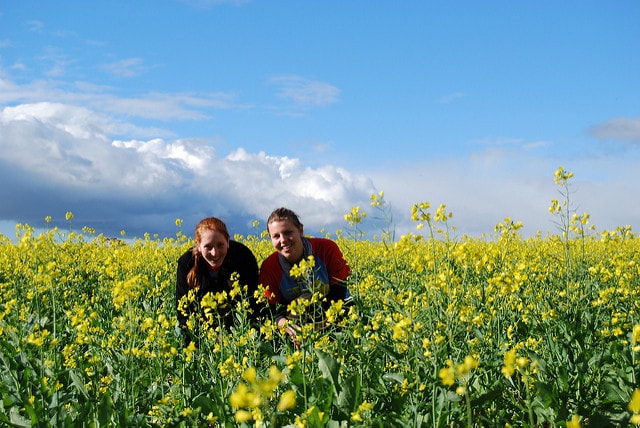 picture credit littleguids via flickr.com
picture credit littleguids via flickr.com
 picture credit Shawn via flickr.com
picture credit Shawn via flickr.com
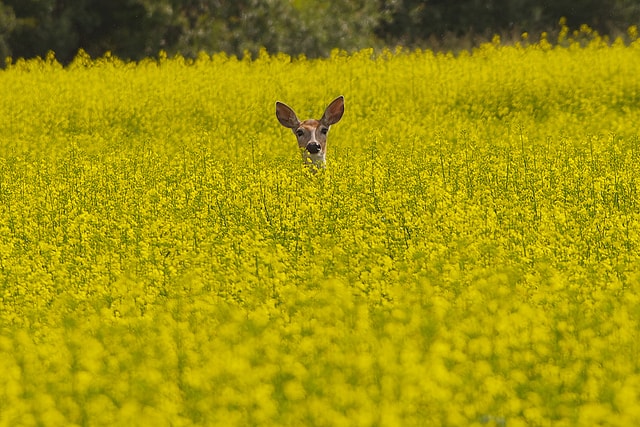 picture credit Mark Iocchelli via flickr.com
picture credit Mark Iocchelli via flickr.com
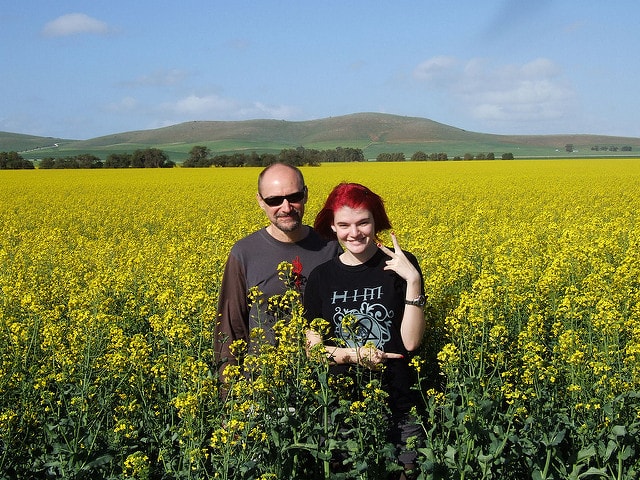 Picture credit Ruben Schade via flickr.com
Picture credit Ruben Schade via flickr.com
========
References:
Featured picture credit kT LindSAy via flickr.com



